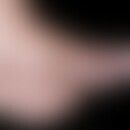Synonym(s)
HistoryThis section has been translated automatically.
Fabry, 1915
DefinitionThis section has been translated automatically.
Not quite rare, unilateral, mostly monotopic, gynecotropic, venous malformation mainly of the lower extremity.
You might also be interested in
ManifestationThis section has been translated automatically.
Mostly congenital, rarely occurring during childhood. Women are 3 times more frequently affected than men.
LocalizationThis section has been translated automatically.
Lower extremities, rare strain.
Clinical featuresThis section has been translated automatically.
Single or plural, isolated or confluent, light red to violet-red, but in places also blue to black-red or black (thrombosed), flat but also sour, clearly consistency increased plaques or nodules.
Single plaques usually only a few centimetres in size; confluent plaques up to the size of the palm of the hand, possibly affecting an entire limb; also possible in a linear arrangement. Usually no subjective complaints.
Local accidental bleeding possible.
Commonly occurring as a sign of complex venous malformation in combination with nevus flammeus, veinctasia and osteohypertrophy.
S.a.u. Cobb syndrome.
HistologyThis section has been translated automatically.
Hyperkeratosis, papillomatosis, irregular acanthosis. Volumes of strongly dilated, erythrocyte-filled capillaries throughout the corium, sometimes extending into the subcutis.
Various authors refer to the angiokeratoma circumscriptum with vascular parts reaching the deep tissue layers including subcutis and fascia as verrucous hemangioma.
Differential diagnosisThis section has been translated automatically.
TherapyThis section has been translated automatically.
Progression/forecastThis section has been translated automatically.
Initially mostly flat, well compressible, red-blue plaque; over the years proportional size growth; at the same time thickness growth with a verrucous surface. No regression tendency. Not infrequently, surface bleeding after banal injuries and thrombosis so that the colour can change from red-blue to homogeneous black (DD: malignant melanoma).
LiteratureThis section has been translated automatically.
- Anderson W (1898) A case of "angio-keratoma". Br J Dermatol (Oxford) 10: 113-117
- del Pozo J, Fonseca E (2005) Angiokeratoma circumscriptum naeviforme: successful treatment with carbon-dioxide laser vaporization. Dermatol Surg 31: 232-236
- Fabry J (1915) On a case of angiokeratoma circumscriptum of the left thigh. Dermatological Journal 22: 1-4
- Fabry J (1916) On the clinic and etiology of angiokeratoma. Archiv für Dermatologie und Syphilis (Berlin) 123: 294-307.
Occella C et al (1995) Argon laser treatment of cutaneous multiple angiokeratomas. Dermatol Surg 21: 170-172
- Sadana D et al (2014) Angiokeratoma circumscriptum in a young male. Indian J Dermatol 59:85-87
- Vijaikumar M et al (2003) Angiokeratoma circumscriptum of the tongue. Pediatr Dermatol 20: 180-182
-
Wang Let al (2014) Verrucous hemangioma: a clinicopathological and immunohistochemical analysis of 74 cases. J Cutan Pathol 41:823-830.
Incoming links (9)
Angiokeratoma corporis naeviforme; Angiokeratoma naeviforme; Angiokeratome, solitary; Blood vessel nevi; Blood vessel nevi; Haemangioma verrucosum; Mibelli's angiokeratoma; Mibelli's angiokeratoma; Verrucous hemangioma ;Outgoing links (11)
Acanthosis; Argon laser; Cobb syndrome; Excision; Hyperkeratoses; Kaposi's sarcoma (overview); Laser; Local anesthesia; Lymphangioma circumscriptum; Melanoma cutaneous; ... Show allDisclaimer
Please ask your physician for a reliable diagnosis. This website is only meant as a reference.

















